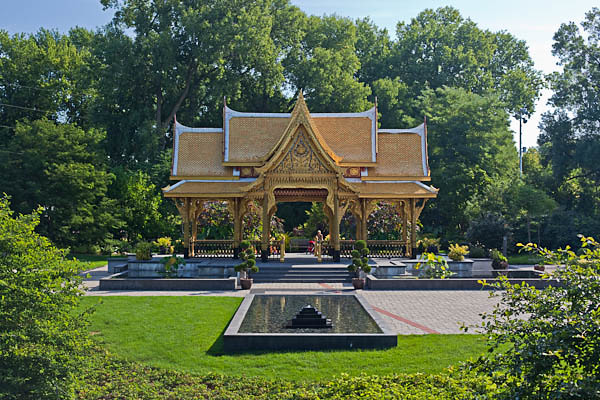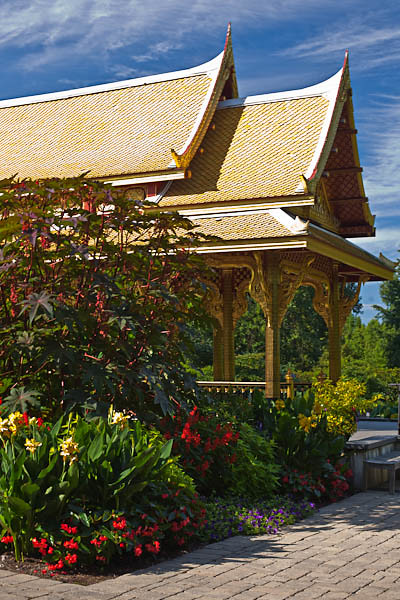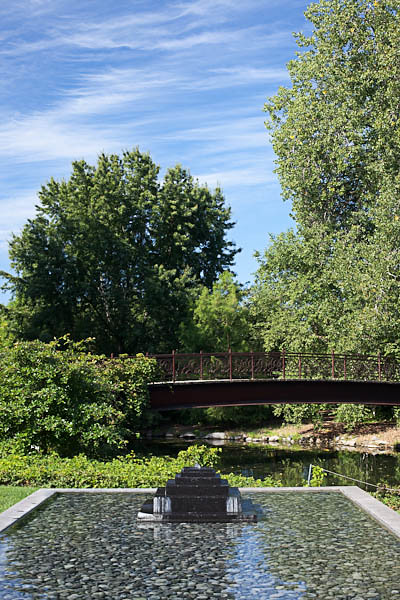Let us not look back in anger, nor forward in fear, but around in awareness. ~James Thurber
A pavilion, or sala, is a common structure in Thailand. Simply constructed pavilions are found throughout the country, often at roadsides, and are used as shelters from rain and heat.
Olbrich’s Pavilion is more ornate than traditional salas; it is more representative of those found at a temple or on a palace grounds. However, Olbrich’s Thai Pavilion is not a religious structure.
The Thai Pavilion was a gift to the University of Wisconsin-Madison from the Thai Government and the Thai Chapter of the Wisconsin Alumni Association. The University of Wisconsin at Madison has one of the largest Thai student populations of any United States college or university, and many Thai people have a strong relationship with the people of Wisconsin.
Thai artisans built the pavilion in Thailand by hand. It was constructed without the use of any nails or screws, using traditional building methods. It was then disassembled and packed in shipping crates. The crated pavilion traveled by sea, rail and truck, arriving in Madison after 11 weeks of global travel.
Nine Thai artisans who built the Pavilion in Thailand flew from their home country to Chicago on 9-11-01, exactly 10 years ago today. The artisans were on the very last plane to fly into O’Hare International Airport in Chicago on that fateful day, on 9-11-01, the day of the terrorist attacks in New York City, Washington D.C. and Pennsylvania.
The Thai Pavilion was carefully assembled in three weeks by these artisans, as most Americans attempted to understand and cope with the 9-11 tragedy. Building the pavilion without hammer or saw was quiet, solemn work. The raising of this meaningful structure, a treasured gift from Thailand, was in strong contrast to the tragedy that occurred on 9-11.
The Thai Garden looks much like a lush, tropical garden, but it has been scrupulously planted with look-alike, Wisconsin-hardy plants. Ornamental grasses and a variety of hardy bamboos help create the tropical look. Large-leafed shrubs and trees are also pruned to simulate the look of typical Thai plants found in gardens there.
The Thai Garden is connected to the other gardens in Olbrich by a 155-foot arched, ornamental bridge that crosses Starkweather Creek. A winding path passes through a forested area and features several stone statues that are symbolic Thai figures. The path eventually leads to a grassy clearing and then the side entrance to the Pavilion.
The fountain stretches from the Pavilion towards the bridge. The large water basin is only a few inches deep, but has a layer of smooth gray pebbles on the bottom which adds constantly changing visual details.
The Thai Pavilion is only one of four located outside of Thailand. The others are in Germany, Norway, and Hawaii. Olbrich’s Thai Pavilion is the only one in the world that is surrounded by tropical plantings, so it is truly representative of the pavilions or salas that are found in Thailand.
——————–
Bo Mackison is a photographer and the owner of Seeded Earth Studio LLC. She spent the morning at the Thai Pavilion, sitting quietly on a bench near the pavilion and the tropical-looking plants, amidst much beauty and calm. And she thought about many things.









